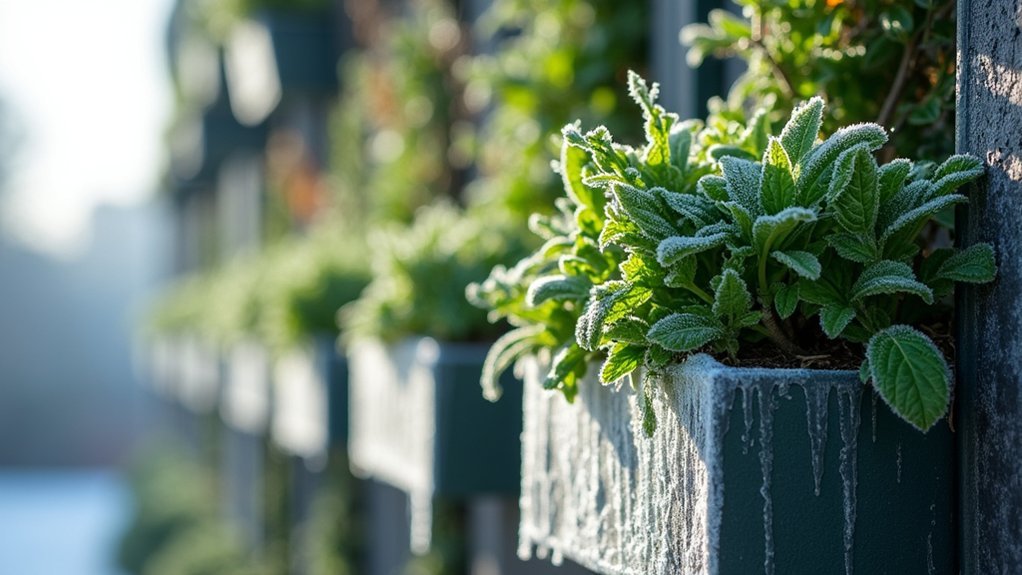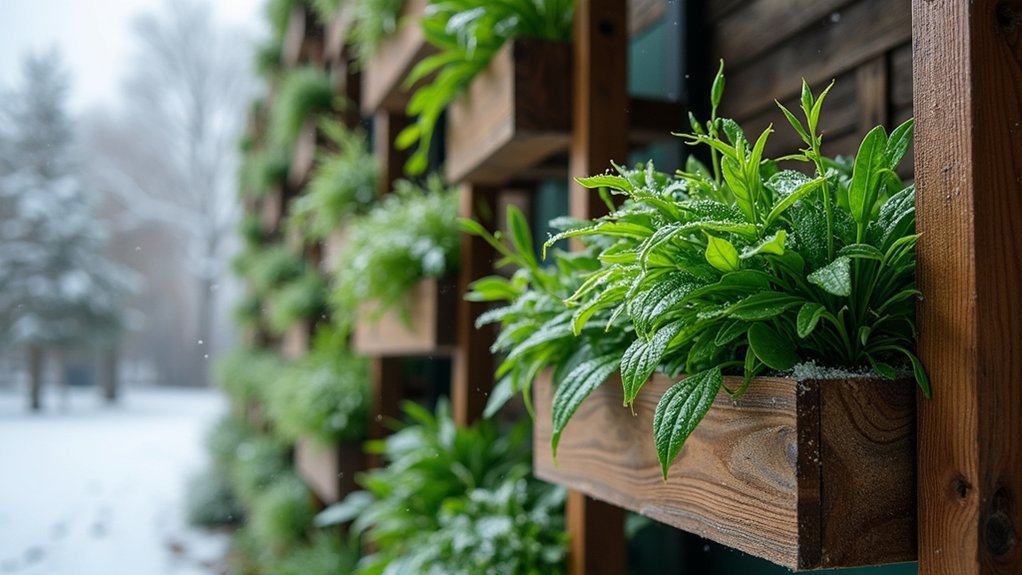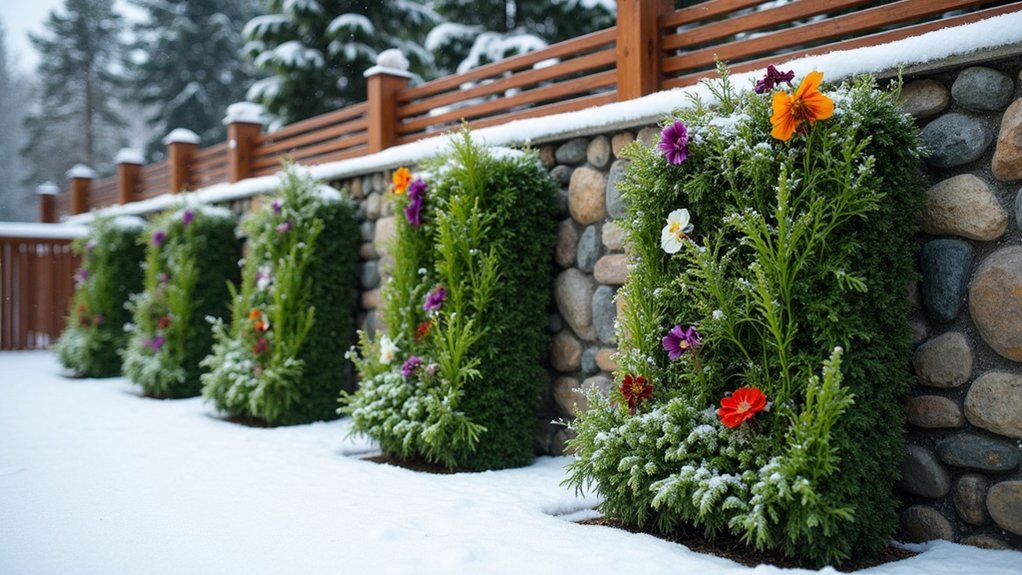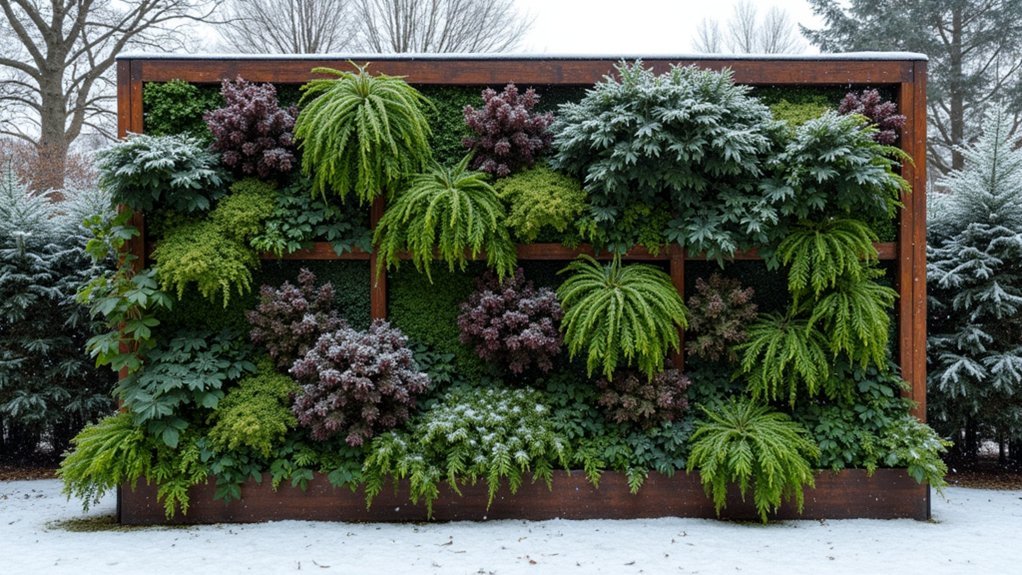Winter-proof vertical gardens create effective natural boundaries while adding visual interest to your landscape. Choose cold-hardy plants like ornamental kale, pansies, and snapdragons that withstand frost. Build sturdy frames that support 50-100 pounds per square foot with cross-bracing for wind protection. Install windbreaks and use clear plastic sheeting to create a protective microclimate. Incorporate proper drainage and regular maintenance checks to guarantee year-round beauty. With these essentials, your living boundary will thrive through every season.
Designing Resilient Vertical Gardens for Winter Boundaries

While many gardeners dismantle their outdoor spaces during winter months, vertical gardens can continue serving as functional, beautiful boundaries year-round with proper planning.
Select hardy plants like ornamental kale, pansies, and snapdragons that withstand cold weather and maintain visual interest despite frost.
Winter-ready vertical gardens shine with ornamental kale, pansies, and snapdragons—bringing color and texture to your boundaries when other gardens sleep.
You’ll need to guarantee proper drainage to prevent root rot when temperatures fluctuate.
Consider installing lightweight plastic sheeting that can trap warmth from interior walls during freezes, creating a microclimate for your plants. For extra protection, add heating elements behind your vertical structure to maintain consistent temperatures.
Your vertical garden not only maximizes limited space in urban settings or small yards but also provides privacy while remaining visually striking throughout winter—proving that effective boundaries don’t need to hibernate when temperatures drop.
Cold-Hardy Plant Selection for Living Walls
Success in winter vertical gardening hinges on selecting plants that not only survive but thrive in colder temperatures. Your Jacksonville vertical garden can remain vibrant throughout winter with strategic cold-hardy plants. Pansies and violas withstand mild frost while maintaining soil moisture levels, making them perfect additions to living walls.
| Plant Type | Winter Appeal | Maintenance |
|---|---|---|
| Snapdragons | Vertical growth | Moderate watering |
| Ornamental kale | Decorative texture | Low maintenance |
| Camellias | Vibrant blooms | Consistent moisture |
Consider incorporating these resilient options to create visual interest during colder months. Snapdragons provide height and structure, while ornamental kale and cabbage offer textural contrast. Camellias deliver pops of color when most plants remain dormant. By selecting plants specifically suited to Jacksonville’s climate, you’ll guarantee your vertical garden remains an attractive boundary year-round.
Structural Considerations for Winter-Resistant Garden Barriers

When designing your winter-ready vertical garden, you’ll need a structural framework made from treated wood or metal that can support additional snow weight and resist frost heaving.
You should integrate wind protection systems like burlap screens or evergreen plant windbreaks to shield your living wall from cold gusts that accelerate heat loss and cause desiccation.
Proper weight distribution across your frame guarantees the garden won’t collapse under winter’s added burdens, with reinforced mounting points at wall connections being particularly vital for long-term stability.
Structural Considerations for Winter-Resistant Garden Barriers
Designing a vertical garden that withstands winter’s harsh conditions requires careful attention to structural elements. Choose weather-resistant materials like treated wood or metal that won’t deteriorate when exposed to freezing temperatures and moisture.
Incorporate insulation features such as air gaps or thermal wraps to enhance durability and effectiveness against winter’s bite. Your structural elements should include sturdy trellises and frames that provide stability against winter winds while supporting your hardy plants.
Select species native to your climate zone, particularly evergreens and cold-resistant perennials, to maintain visual appeal throughout the season. Don’t forget to schedule regular maintenance checks to inspect for cracks or wear that could compromise integrity.
These proactive measures will guarantee your vertical garden barrier remains functional and attractive despite winter’s challenges.
Weight-Bearing Frame Design
Because winter conditions add significant stress to vertical gardens, your weight-bearing frame must be engineered with exceptional strength and durability.
Select treated wood or metal components that can support 50-100 pounds per square foot to withstand soil, plant weight, and snow accumulation.
Don’t overlook cross-bracing in your design—this critical element prevents swaying during high winds and strengthens the entire structure against winter storms.
Secure your weight-bearing frame with concrete footings or deep-set posts to combat frost heave and guarantee stability year-round.
Incorporate strategic drainage features throughout your frame, including holes or channels that prevent water accumulation.
These drainage elements protect your structure from freeze-thaw damage that could compromise the durable materials and structural integrity during the harshest winter conditions.
Wind Protection Systems
Effective wind protection systems form the backbone of any winter-resistant vertical garden, requiring careful material selection and strategic placement. When designing these barriers, opt for treated wood, metal, or composite materials that’ll withstand harsh winter conditions without deteriorating.
Position your barriers to block prevailing winter winds while still allowing sunlight to reach your plants. A height of 6-8 feet provides ideal protection from strong gusts that could damage your garden.
Consider incorporating slatted or lattice designs that reduce wind speed without complete obstruction—this creates beneficial microclimates that enhance plant health.
Don’t neglect maintenance once your system is installed. Regularly check for structural weaknesses and reinforce as needed throughout the winter season to guarantee continuous protection for your vertical garden’s delicate ecosystem.
Protective Strategies for Vertical Gardens During Frost

When winter’s icy grip threatens your vertical garden, implementing protective measures becomes essential for plant survival. Cover your garden with clear plastic sheeting to trap heat from interior walls, creating a microclimate that helps reduce stress on delicate plants. This barrier also protects nearby water features from freezing.
Incorporate heating elements behind your vertical garden to maintain consistent warmth during cold snaps. For an economical solution, install incandescent uplighting at the base, which provides both heat and ambiance to your outdoor space. Christmas lights, especially netted versions, offer another warming option while enhancing visual appeal.
Don’t forget proper drainage around your vertical garden—pooling water can freeze and cause root rot, devastating your living boundary faster than the frost itself.
Multi-Season Appeal: Beyond Winter Functionality
While protecting your vertical garden during frosty months guarantees survival, these living installations offer far more than cold-weather resilience. Your outdoor living walls transform spaces year-round, providing continuous beauty and functionality regardless of season.
| Season | Visual Appeal | Functional Benefits |
|---|---|---|
| Spring | Flowering vines, fresh greenery | Privacy screens, improved air quality |
| Summer | Lush foliage, vibrant colors | Natural cooling, shade provision |
| Fall/Winter | Evergreens, seasonal berries | Wind protection, insulation |
Installation Techniques for Durable Living Boundaries

Creating winter-resistant vertical boundaries requires strategic installation methods that balance structural integrity with plant health. When setting up your living wall, consider the specific needs of cold-hardy plants while implementing insulation measures to protect roots from freezing temperatures.
Vertical gardens thrive in winter with thoughtful design that prioritizes both plant protection and structural durability.
- Foundation preparation – Establish proper drainage by incorporating gravel layers beneath planting areas and ensuring containers have sufficient drainage holes to prevent water pooling that leads to root rot during freeze-thaw cycles.
- Structural reinforcement – Secure trellises and wall-mounted systems with weather-resistant fasteners that can withstand winter expansion and contraction.
- Protective layering – Install clear plastic sheeting or frost blankets that can be easily deployed during extreme cold while still allowing light penetration, creating a microclimate that maintains warmth in the root zone.
Maintenance Requirements for Year-Round Vertical Gardens
Proper installation sets the stage for success, but the long-term importance of your vertical garden depends on consistent, season-specific maintenance.
Monitor soil moisture diligently, especially during winter when Plants Indoors may need less frequent watering. It’s essential to avoid overwatering succulents, which can quickly develop root rot in soggy conditions.
Establish a regular watering schedule that adapts to seasonal changes, and dust leaves periodically to maximize light absorption and photosynthesis efficiency.
For herbs, frequent pruning and harvesting will promote bushier growth and sustained productivity throughout colder months.
Invest in quality, nutrient-rich potting soil from the beginning—this foundation supports healthy plant development in compact vertical spaces.
These maintenance practices will guarantee your living boundary remains vibrant regardless of outside temperatures.
Integration With Existing Landscape Elements

When designing your winter-proof vertical garden, consider how it will harmonize with your existing landscape features for maximum visual impact.
Trellises and wall planters that complement your home’s architecture create a seamless connection between built structures and living elements. You’ll find that vertical gardens can enhance privacy while naturally blending with existing foliage to create a cohesive outdoor space.
- Position your vertical gardens alongside hardscapes like patios or walkways to maximize limited space while adding visual interest.
- Select plants that either mirror or contrast with ground-level landscaping to create dynamic texture and color relationships.
- Install vertical elements near existing trees or shrubs to boost biodiversity and attract beneficial insects that support your garden’s ecosystem.
Frequently Asked Questions
How Do Vertical Gardens Affect Property Values?
Vertical gardens can boost your property value by enhancing curb appeal, improving air quality, and providing natural insulation. They’re attractive selling points that demonstrate environmental consciousness and creative landscaping, making your home more desirable to buyers.
Can Vertical Gardens Attract Unwanted Wildlife During Winter?
Vertical gardens don’t typically attract unwanted wildlife in winter. Most pests remain dormant during cold months. You’ll see fewer insects, and the limited food availability means animals aren’t likely to frequent your garden wall.
What Are the Water Consumption Implications for Winter Vertical Gardens?
Your winter vertical gardens need less water as plants enter dormancy. You’ll reduce watering frequency by up to 70%, but don’t forget to check soil moisture during warm spells when evaporation can still occur.
Are Permits Required for Installing Substantial Vertical Garden Boundaries?
You’ll likely need permits for substantial garden boundaries that exceed height limits or affect property lines. Check your local zoning codes and HOA rules before installation to avoid potential fines or removal orders.
Do Vertical Gardens Create Microclimates That Impact Surrounding Plants?
Yes, your vertical gardens do create microclimates. They’ll block wind, increase humidity, and modify temperatures nearby. These changes can protect sensitive plants and create beneficial growing conditions for your surrounding garden.
In Summary
Your winter-proof vertical garden isn’t just a boundary—it’s a year-round statement piece that thrives despite frost’s challenges. By selecting cold-hardy plants, implementing sturdy structures, and maintaining seasonal protection, you’ve created living architecture that enhances your landscape’s beauty and privacy. Remember, your vertical garden will continually evolve, requiring attention but rewarding you with dynamic natural boundaries that transform with each passing season.





Leave a Reply